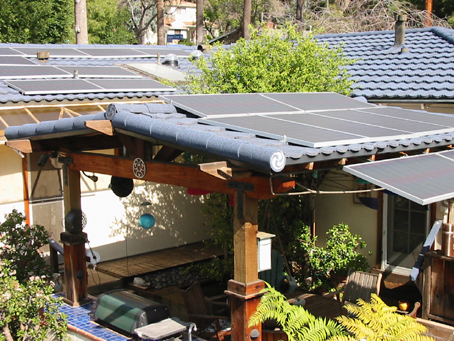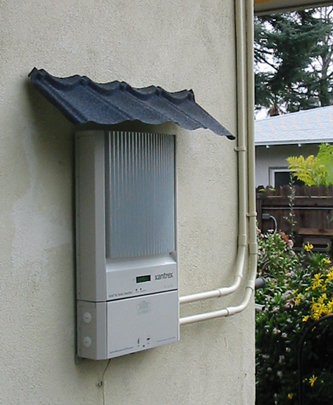|
The image on the right shows the entry to the front patio on the east; The solar panels are on the roof. Until 2009 they were in the southwest corner of the back yard, within a 10 x 30 -foot utility area that also contains a garden toolshed and a compost bin. Once the neighbor's banana tree grew large enough to shade them substantially, I resolved that they should move. The neighbor's yard is beautifully landscaped with these trees, and asking him to cut them down did not seem a good option. In October 2008 the Xantrex grid-tie inverter failed, and I decided to make the change. It took me till January '09 to move them and install a replacement Xantrex. My first version of the system included a bank of batteries for running the lights at night, and to serve as backup for when the grid failed. But the 1.3 kW inverter I used for those purposes failed repeatedly, and then the company, PowerStar, also folded. So I converted the system to do only one task: feed the grid. Although I can no longer point to the lights at night and say, "They're running on solar power," the system is simple, reliable, efficient, and maintenance-free. Solar electricity facilitates a distributed-generation philosophy, aimed toward reducing the need for new large-scale, and often environmentally harmful, central generating stations and distribution lines. My own objectives for the PV system are:
Solar GroovyIn the days following the successful atmospheric entry, descent, and landing of the Mars Exploration Rover, named "Spirit," in the first week of January 2004, reporter Gay Yee picked up and repeated the phrase she heard one of the team's electrical power engineers using. When the rover's batteries are at full charge from the dim Martian sunlight's action on its photovoltaic panels, when it looks like atmospheric dust and opacity will not interfere with plans, "solar groovy" means the rover's batteries and power state are set for the next maneuvers.My housemate Mitch flinches at the sound of that 1960's word, but I've adapted the phrase to mean the electric meter here at the house is spinning backwards. We're "solar groovy" even on a rainy day.
Their nearest retail outlet was in San Diego, so my friend Ken and I drove down there on a Saturday to visit Solar Electric Inc. (which changed to "Discover Power" years later after Mike, the original owner, passed away). We loaded up my Saturn wagon with eight batteries (see the old system version) and a few UniSolar US64 panels, each rated at 64 watts. We gathered lots of literature, and I spent the weekend mounting the US64s on the steel structure I had built in back, reading all the literature, and arriving at a decision as to how to configure a system, and what electronics to use. Those panels, and more that I bought later, have now been moved to the roof as can be seen in the image above. The US64 photovoltaic panels connect electrically in series via a short 14-gauge run of Romex into a conduit where they join a 12-gauge pair that runs to the Xantrex, with a nominal voltage of 340 VDC. There are two series strings of sixteen US64s. Each connects to one of the Xantrex's two parallel PV string inputs. Unisolar stopped producing panels like the US64 in 2007. Instead of manufacturing units with aluminum frames and connection boxes, UniSolar is now concentrating on producing continuous PV sheets for use in large commercial PV installations.
The Xantrex Grid Inter-tieThe image on the right shows the new Xantrex GT2.8 grid inter-tie inverter taking lots of high-voltage DC, through the lower conduit, and quietly (no fan!) churning out 240 VAC into the utility grid, through the upper conduit. The idea is called "net metering." The grid serves as a virtual battery that works at 120/240 VAC. You "charge" the grid as you can, and use from it as you need, then pay the power company for any excess you use. Per the agreement, you have to forfeit any excess that you supply on a yearly net basis, so it wouldn't pay to install a monster system.This Xantrex's readout tells you how many watts it's producing, updated every second, and a tally of how many kilowatt-hours it has produced each day. There's also a running total of kWh over the unit's lifetime. Once in a while the grid voltage climbs up over 135 VAC on each leg (270 V total service). Ouch! The Xantrex disconnects, preventing damage to its electronics, but requiring a call to Southern California Edison to nag them to return the voltage to specification (240 VAC plus or minus 5%). When the Edison power sags to 211 VAC, the good ol' Xantrex disconnects again. Interesting to note, Edison's poor regulation results in more revenue for them. High voltage makes everyone's meter spin faster, and disconnects any solar systems in the neighborhood so their owners have to BUY power instead of selling it. Bad Edison!
The State of California kicks in for your PV SystemThe California Energy Commission is offering cash rebates on eligible renewable energy electric-generating systems through their Emerging Renewables Program. To be eligible, your system must be on the electrical utility grid, and must remain connected to it. Mine was 50% of the installed cost, in 2002. It seems to change, but it's still a pretty hefty rebate.There's also a California State tax credit. Other states probably have similar programs.
System Components
Schematic DiagramThis diagram shows the system feeding the utility grid to slow down the electric meter and often runs it backwards. An agreement is signed with the utility, Southern California Edison. The intertie unit it pretty smart. It senses and then matches phase with the 240 VAC power on the grid. It cuts off in case of grid failure, to prevent a shock hazard for the utility repair crew. It even complies with a plan that prevents it from thinking someone else's intertie is the utility power (anti-islanding). Thirty-two US64 PV panels fill out two series arrays. The intertie unit, with its own rain-proof housing, is on the west side of the house.
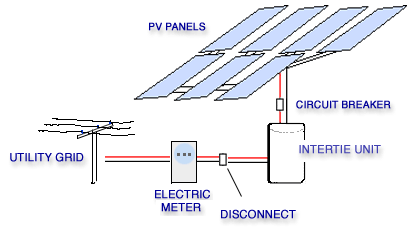
What the Utility Company Likes To See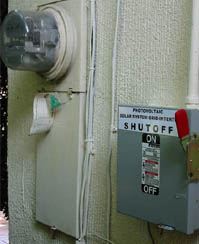 The Xantrex utility intertie unit's manual says to mount the intertie unit as close as possible to the electric meter. I chose to mount it on the opposite corner of the house from the meter, and connect the 240VAC over a run of 10-gauge wire and conduit. As long as there's a clearly labelled disconnect switch close to the meter, the County electrical inspector and the Utility Company are happy. (Since there's already adequate disconnect and circuit-breaking capability in the intertie unit, the disconnect switch is technically redundant.) They also like to see a yellow tag identifying the Net Metering Agreement generating station approval (the photo was taken a few days before there was a tag).
The Xantrex utility intertie unit's manual says to mount the intertie unit as close as possible to the electric meter. I chose to mount it on the opposite corner of the house from the meter, and connect the 240VAC over a run of 10-gauge wire and conduit. As long as there's a clearly labelled disconnect switch close to the meter, the County electrical inspector and the Utility Company are happy. (Since there's already adequate disconnect and circuit-breaking capability in the intertie unit, the disconnect switch is technically redundant.) They also like to see a yellow tag identifying the Net Metering Agreement generating station approval (the photo was taken a few days before there was a tag).
Solar Heated WaterThe HotSpring brand hot tub I installed in August 2001 uses a 1.5kW electric heating element to heat the water. Its design is good in that it doesn't come in contact with the water and will therefore last forever-ish. But man, did it soak up those kilowatts. In winter, the temperature in the tub decreases four degrees Fahrenheit each night, so it used to keep burning up the electricity. Obviously, its conversion to solar water heating was a high priority. As of mid-January '03 it was done, and works very well. Selecting the system components, though, turned out to be very time consuming.As for hot water for bathing, laundry, etc., I haven't endeavored to convert from natural gas yet. I did go ahead and convert from tank-type to demand-type to increase the efficiency. A solar water collector is in place too, so maybe later I can work in some sort of heat exchanging system to pre-heat household water.
Solar Assisted Clothes Dryer Of course there's a place outside the laundry room for hanging a few clothes on hangers in the sun. But for years I'd been wanting to figure out a way to force solar-heated air into a tumbling clothes drier.
Of course there's a place outside the laundry room for hanging a few clothes on hangers in the sun. But for years I'd been wanting to figure out a way to force solar-heated air into a tumbling clothes drier.
First thoughts were always about how to make a solar hot air collector, and maybe buy an old clothes drier to convert. Then, one sunny afternoon I was crawling around the low attic space running wires, sweating by the liter. "Duh!" I realized what to do. It would be much simpler! A 4-inch diameter hole, near the apex of the stucco firewall in the garage, was the first component. Then a bent-tin "manifold" went on the back of the drier to take over its air intake grills. You can see that in the photo at right. A flexible duct now delivers hot, dry air from the attic space to the drier. A small fan inside the duct "turbocharges" the flow while the drier runs, to overcome the added path-friction. I'd like to think it requires burning less natural gas now, but I haven't tried to quantify results yet. At least you can decide to set it on "Air Fluff" in the afternoon and use only the solar-heated air.
If you're considering a solar system of your own, I'd be pleased to have you drop by for a look at this. Call or send me an email. -- Dave [dave (at) SpacecraftKits dot com]
| |||||||||||||||||||||||||||||||||||||||||||||||||||||||||

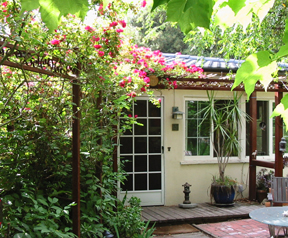 In April 2002 I decided to design and implement a residential solar photovoltaic (PV) system for my house in Altadena (California). As of June 25 that year, the first version was finished. Today, it feeds one and a half kilowatts into the grid that we draw from, hour after sunny hour.
In April 2002 I decided to design and implement a residential solar photovoltaic (PV) system for my house in Altadena (California). As of June 25 that year, the first version was finished. Today, it feeds one and a half kilowatts into the grid that we draw from, hour after sunny hour.
